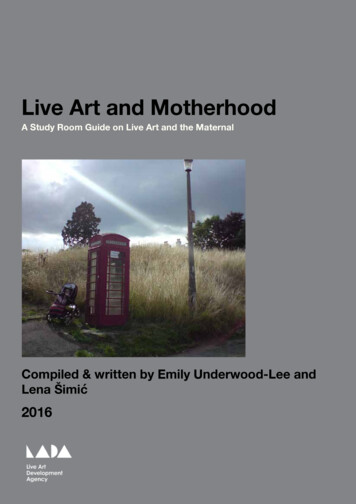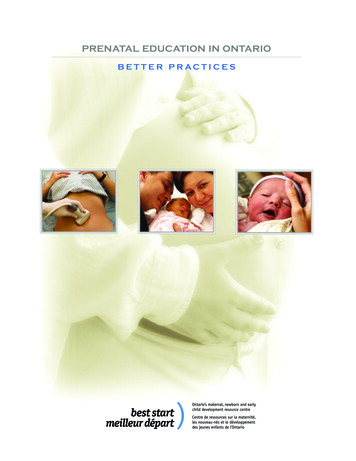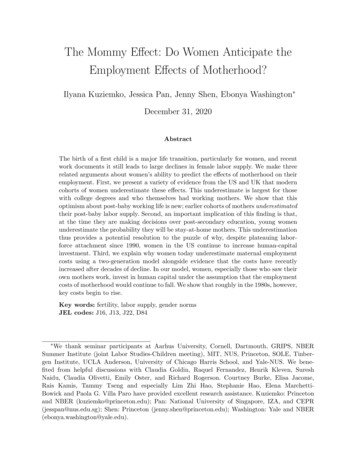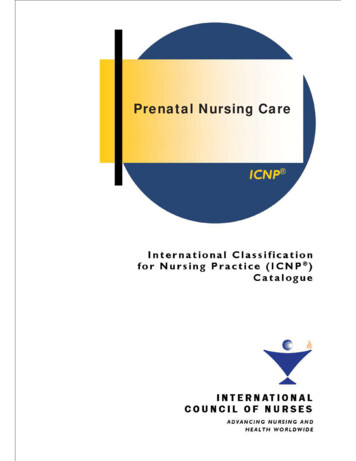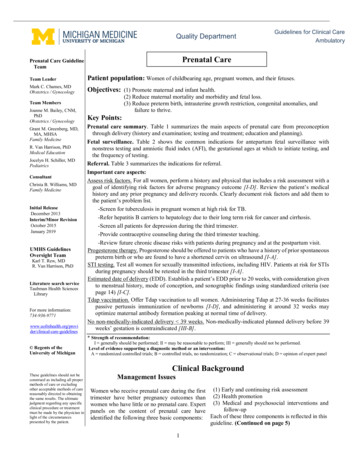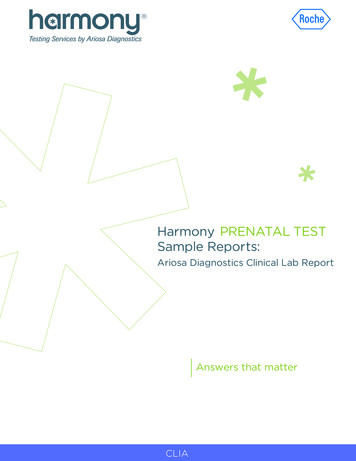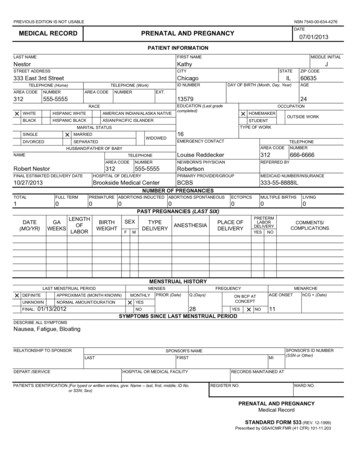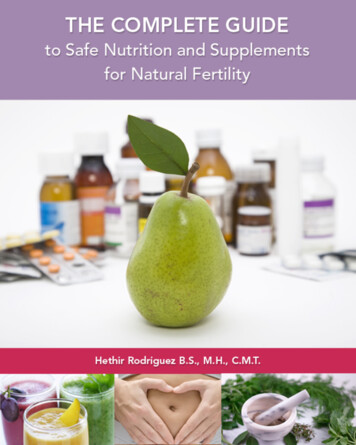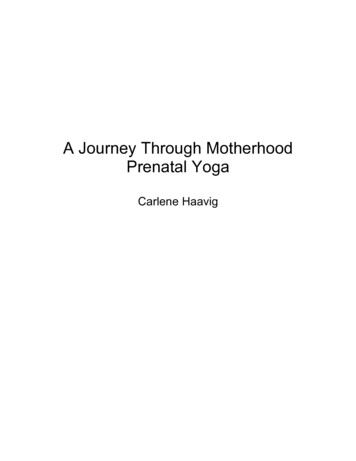
Transcription
A Journey Through MotherhoodPrenatal YogaCarlene Haavig
Prenatal YogaI had just began my Yoga Teacher Certification Training at Prairie Yoga and wasexcited for a new chapter in my life to learn more about myself and to furtherdeepen my yoga practice. At the time, I had a two-year-old son at home and hadrecently quit my full time job to be at home with him more often. While I lovedbeing able to stay at home with my son, and I was extremely grateful to not haveto take the train into the city every day, sit in an office and miss out on so manyprecious moments of childhood, I also felt isolated and like I was losing part ofwho I was and my identity as a woman, not just a mom. I had been doing yogafor a little over six years at the time and over the years my practice had becomea passion, lifestyle and solitude for me. I remember sitting in a CPR class that Ihad to take for my job and talking to a lady who was in my class who had to getcertified for her Yoga Teacher Certification requirements. All of the sudden, it hitme. This is what I should be doing with my life. For the first time in a long time Iwas confident in my future, not just as a mom but also as an individual. I felt adeep sense of the possibility of balance, which previously seemed sounachievable for me as a mom. Working full time was terrible; staying at homewasn’t that great for me either. I was currently working part-time at a job I neitherloved nor hated. All of the sudden, I was enrolled in the training program and feltlike for the first time in a while I was doing something for just me again.Something that was going to improve me as a person and give me the flexiblecareer that I had been dreaming about since I quit my full time job. And the bestpart, it was something that I loved doing more than anything. I was about amonth into the program and fully enjoying an entire day a week of “selfish” metime away from my 2 year old learning about yoga and spending time with otheradults. I was extremely ready to take the rest of the year for myself. To be“selfish,” for the benefit of my family, of course, and put some extra householdwork on my husband as I took my own personal journey of self-discovery,enlightenment and independence.It felt amazing. Then, to my surprise, a month into my training I found out that Iwas pregnant. My dream of selfish me-time and independence suddenly had adifferent look to it. I had just begun the journey of expanding my mind andteaching my body to do rigorous yoga postures in an advanced environmentwhen all of the sudden, motherhood changed my path and my plans once again.Of course I was filled with joy over my pregnancy. I truly wanted another childvery much and was planning to try to have another one, once my Yoga TeacherCertification was complete. I thought about postponing my teacher training until alater point in my life when I was not so physically restricted. But then I realizedthat I would always have a reason to postpone the training, especially with twoyoung children, and that it may be years before I found myself presented with thetime and the opportunity to complete a 9-month yoga training program again. Idecided to stick to the training and continue my path of learning so that I couldhave the career that I wanted once my second baby was born. I am so glad that Idid. If I had known how hard it was going to be, I might have quit then and there,
however, I have learned more than I ever thought possible and grown in waysthat I never before imagined. As both a mom and an individual. So there I was, 9months ahead of me of pregnancy, 8 months ahead of me of yoga teachertraining, ready to take on a great challenge and what turned out to be one of thegreatest journeys of my life.Over the past year, prenatal yoga has taken on an entirely different meaning forme than ever before. I have lived it, learned it and used it to help me grow as awoman and as mom and take care of my baby and myself. It has become asacred and deeply meaningful topic for me and I feel blessed beyond belief tohave had to experience of going through my teacher training while pregnant.While it was not always fun or easy, it was rewarding beyond belief and teachingyoga to moms-to-be has become a topic of great passion and importance to me.Over the past year, I have learned to be in tune with my body and my baby inways that I never imagined, be a more present and patient mother to my 2-yearold son, and let go of my ego of what yoga asanas should be and accept thesacred place that I am in my life right now.This thesis is based mostly on my own personal experiences as I journey throughthe wonders of pregnancy and the benefits of yoga. I have also had manyinspiring and helpful teachers and read many useful books along the way to helpme with my journey. Much of the information in this theses is referenced fromvarious sources (including my own personal experience, insights, and opinions)but also, Lori Gaspar and Rebecca Stiles, my amazing yoga teachers throughoutmy training experience at Prairie Yoga; Dee Davis, certified and long timeprenatal yoga teacher, who I had the pleasure of meeting during a prenatal yogaworkshop at Prairie Yoga; Kathleen Wright, a fabulous and experienced Iyengarteacher who taught me many wonderful prenatal yoga modifications during a 2day workshop I took at Prairie Yoga; and 2 of the best pregnancy books I haveever read: “Yoga Mama Yoga Baby” by Margo Shapiro Bachman and “IyengarYoga for Motherhood” by Geeta S. Iyengar.1: Yoga and Health: The Many Benefits of Yoga During PregnancyPracticing yoga while pregnant is definitely not a new ritual or a passing fad. Infact, it has been regarded in India as a healthy and beneficial practice for womanduring pregnancy for a very long time. T. Krishnamacharya was a huge advocateof practicing traditional Yogic and Ayurvedic practices while pregnant and taughtmany of his students the various health benefits of having a yoga practice whilepregnant (Health, Healing and Beyond, T.K.V Desikachar.) Yoga helps tostrengthen, refine and stabilize your body, breath and mind (Margo Bachman)and there are countless benefits of practicing yoga while you are pregnant.Prenatal yoga helps good digestion, healthy blood circulation and light easybreathing. Asanas and pranayama help to end tiredness and nervous tension,and to rid the body of toxins. Yoga not only can benefit a healthy and morecomfortable pregnancy, but if recommended postures are practiced regularly, it
can help prepare for an easy and natural childbirth. Poses that encourageopening of the hips and pelvis can facilitate comfort throughout the pregnancyand possibly an easier labor. Empirical tests have proven that not only thephysical health of an expectant mother but also her emotional and mental stateaffects the future health and development of the unborn child. Yoga, pranayama,meditation and a healthy lifestyle can highly enhance the child’s future health, aswell as the mother’s. (Iyengar Yoga for Motherhood, Geeta Iyengar).Some of the many benefits of prenatal yoga are: Improves well beingImproves physical control and balanceImproves blood circulationRelaxes the bodyStrengthens musclesImproves flexibilityOpens and tones the pelvic floorHelps with deliveryHelps with nausea, especially during the first trimesterHelps with depression, which can be common during pregnancyStrengthens pelvic floor, which helps with labor and deliveryHelps pelvic floor get back in shape faster after deliveryMay shorten 2nd stage of laborDee Davis Prenatal workshopPossible Discomforts During Pregnancy that Yoga Helps to Alleviate Morning sicknessWeakness and fatigueShortness of breathHeartburnSwollen legs and feetVaricose veinsBack painHigh blood pressureToxemiaHeadacheDizzinessNumbnessUrinary problemsGeeta IyengarThroughout my pregnancy, yoga helped me to keep up my energy level, focus ona healthy lifestyle and increase circulation in my body. When I practiced in the
morning, it would help me recharge and get ready for the day. It gave me energyand made my body feel lighter. It helped a lot with my circulation and helped mefocus on staying healthy and active throughout my pregnancy. When I practicedin the evening, it helped me to relax and sleep better. It was a huge relief forback pain, sore muscles, and headaches. While my practice changed during mypregnancy, I still worked to maintain a regular practice. Sometimes I found itchallenging to practice my usual hour and a half studio class and on days when Ilacked the energy, I opted for shorter practices at home. Sometimes I did multipleshorter practices a day. I did not push myself and allowed my practices to adaptto my daily needs. I found that practicing for 15 minutes in the morning and 30minutes in the afternoon or evening really helped me to relax, stay energized andkeep my body feeling toned and strong. Just the basic act of stretching whilepregnant was a huge relief to circulation issues and helped to reduce swelling inmy legs and feet. It also improved my mood and kept me feeling healthy while Iwas pregnant.Each trimester is different and brings about different hormones and energy levelsduring pregnancy. It is different for every woman, but I found that the firsttrimester was often the hardest time to practice yoga because I felt sick,nauseous and exhausted all of the time. Some days all I could honestly managewas to breath and eat chocolate. However, during the first trimester, practicing alight restorative yoga really did help with my morning sickness and also helped toalleviate the terrible hormonal headaches I was suffering throughout my firsttrimester. On the days that it was a challenge for me to keep up with my regularpractice, I opted for a few restorative postures such as Viparita Karani, SuptaBaddha Konasana, and a supported Prasarita Padottanasana with blocks. Then Iwould work on a relaxing pranayama practice for 5 or 10 minutes such as asimple belly breathing practice. Some days this was all I managed but it reallyhelped. During my first pregnancy, it was easy to rest when I needed to rest,however, the second time around with a 2-year old running around was a littlemore complicated when it came to taking care of myself. I found that when Ipracticed restorative yoga it would bring me back to the present moment, help toclear my mind and settle my hormones and emotions, and it really helped withmy energy, fatigue and nausea. I took it very easy on my body during my firsttrimester because it is the most delicate point in the pregnancy for the fetus and Iwanted to be as cautious as possible. I focused heavily on restorative yoga andlight gentle breathing.As I approached the relief of my second trimester, I really enjoyed and got intomy yoga practice once again. I had my energy back and I was not as limited inthe postures that I could practice. The first trimester is actually the most limiting, Ifound, because the body is at it’s highest risk of miscarriage and it is extremelyimportant to be very cautious when practicing yoga, or any other physicalexercise. Once the second trimester starts, there is a lot more that the body canhandle and I felt physically and mentally more capable to practice as my fatigue,morning sickness and hormonal headaches subsided. Yoga helped me to stay
strong and flexible while in my second trimester and helped me to focus on a lifestyle where I was nurturing my baby and myself. When I got into my thirdtrimester, practicing yoga helped me with the fatigue that was once againcreeping in and was a great relief in circulation issues as well as back pain. As Ineared the end of my pregnancy, my practices got shorter and I stopped going tomy usual hour and a half classes entirely and focused on my at home practiceand doing postures that my body needed the most in doable increments of 15-30minutes. I would try to practice once in the morning, even if for only 10 minutes,and once in the afternoon once my son was down for a nap. I found that as Ineared the end of my third trimester, pushing myself in long classes was not bestfor my body but maintaining a regular practice still felt amazing and had so manybenefits, especially for better sleep, circulation and back pain. Learning to modifyyour practice to your daily needs is so important, especially while pregnant, andallows for the greatest benefits and enjoyment out of your personal practice.I also noticed that a healthy yoga practice helped me through an easy andnatural labor and helped my body recover and bounce back to normal after myfirst pregnancy, even after having a 9-pound baby. Practicing yoga was not onlyextremely beneficial on my body and health, but it kept me relaxed and helpedme to stay clear, focused and happy during my pregnancy. It helped me live inthe moment, appreciate the stage I was at in life, and be thankful for my manyblessings during my pregnancy. I never felt more connected to my body and ithelped me feel connected to my baby as well.2. Pregnancy and Yoga: General Rules and Restrictions for Prenatal YogaPrenatal yoga can be a wonderful source of exercise during pregnancy and anexcellent way to focus on your health and help to alleviate many ailments anddiscomforts that naturally arise in the body while pregnant. However, your body isin a very delicate and precious state during your pregnancy and it is not a time topush or challenge your physical capabilities. Gentle, traditional yoga can providemany benefits while pregnant, but it is also very important to know andunderstand the general rules and restrictions of practicing yoga while pregnant.And it is important to always practice under a knowledgeable teacher and onlyafter the approval of your doctor. I can not stress how important it is to modifyyour practice to your daily mental and physical needs while pregnant. I you gointo your pregnancy expecting to maintain your usual practice, you will notreceive as many of the possible benefits and you may leave yourself feelingmentally and physically drained.General Rules During Prenatal Yoga Practice If you are in your first trimester, or if you have a high-risk pregnancy orhistory of miscarriage, consult your doctor before practicing yoga or anyother physical exercise. For high-risk pregnancies and woman with highrisk of miscarriage, practicing yoga is not recommended during the first
trimester. After the first trimester, with consultation of your doctor,restorative and supported postures can be practiced.If you have never practiced yoga before pregnancy, you should onlypractice prenatal yoga with a knowledgeable teacher.If you had a strong yoga practice previous to your pregnancy, you cancontinue most of your previous practice with modifications after your firsttrimester (there are a few posture restrictions that should be avoidedentirely, see below section on “Restrictions”).During the first trimester, all prenatal yogis should do a gentle practice ornone at all as the fetus is still implanting and the risk of miscarriage ishighest.Avoid breath retention in pranayama, it limits baby’s oxygen supply andcan leave mom feeling dizzy, light-headed and agitated.Since oxygen supply is decreased during exercise, modify intensity, drinka lot of water, and stop your practice when fatigued.Avoid laying on the back after the first trimester to avoid pressure on thevena cava (the spine behind the uterus).Stop is there is unexplained discomfort, pain, leakage, bleeding, cramping,difficulty in breathing, pain in chest, increased swelling, or headaches.Avoid jumping and jolting exercises.Drink extra water, as dehydration is more common while pregnant.Avoid inversions during pregnancy. ****Focus on maintaining good posture in yoga asanas throughout pregnancy.As the uterus enlarges, changes in posture can occur. A poorly alignedspine can put increased strain on the muscles and pelvis and lead to neckand back pain, poor breathing from congestion of the lungs, swollenankles, and sore knees. Good posture begins at the feet; head and neckshould be erect, pelvis and shoulders aligned, chest open and legs strongand balanced.During pregnancy, a hormone called “relaxin” is released into the body. Itis meant to soften ligaments, especially in the pelvis girdle. It is importantnot to take joints past their normal range of motion, even though therelaxin may allow it. It can cause pain and tears in the ligaments. Allligaments soften, especially the feet so it best to use caution in activitiesthat are hard on the feet. Make sure to elevate the feet after a long dayand stay off of them and rest when possible. Relaxin can also causeweakness in the joints so it is best to avoid postures that put to muchpressure on weak joints and ligaments, especially the wrists.*Practicing inversions during pregnancy is a very controversial topic andopinions vary based on different styles of yoga and various teachers.Prairie Yoga and Prenatal Yoga Teacher Dee Davis recommends notpracticing any type of inversion during pregnancy, with the exception ofAdho-Mukha-Svanasana (downward facing dog). On the other hand, inthe Iyengar school of yoga, teachers such as Geeta Iyengar and KathleenWright believe that gentle inversions with proper props, modifications, and
teaching instruction can be very beneficial and soothing to the baby. Iwould definitely not teach or recommend practicing inversions in aprenatal yoga class, and would definitely not recommend practicinginversions to new or inexperienced students. If the student is experiencedin yoga, has a strong inversion practice prior to pregnancy, is workingunder a knowledgeable teacher and is using the proper modifications andprops, restorative inversions can feel very good for relaxation and creatingspace in the abdomen. I practiced headstand against the wall and in astudio with a teacher I trusted throughout my first and second trimester. Istopped by the end of the second trimester because my balance felt offand it was challenging to get into the posture. At this point, I did a modifiedheadstand against the wall using blocks and keeping my feet on theground (*see photo session of modifications). I also learned a brilliant wayto practice shoulder stand in a Kathleen Wright workshop that I took atPrairie Yoga where the student is against a wall with a set up of 5 blanketsand bent legs with both feet resting on the wall for support. I think knowingyour body, trusting your teachers and your practice, and knowing the risksand benefits are key.Postures to avoid during pregnancy Deep lumbar twists, as they serve to cleanse and flush the system. This isespecially crucial during the first trimester when the fetus is at its mostfragile state. Avoid practicing postures such as Parivritta Trikonasana,Ardha Matsydendrasana and Marichyasana throughout the entirety ofpregnancy. Instead, it is safe to practice gentle open twists, such asBharadvajasana.Stomach compression, such as Navasana, Ardha Navasana and Plank.Deep forward bends, such as Pachimottanasana. Some forward bends,such as Uttanasana, can be modified by spreading the legs a furtherdistance apart to make room for the belly and by using blocks to make thebend less intense. Upavista Konasana and Janu Sirsasana can bemodified my using a strap and not folding forward deeply. PrasarittaPaddotanasana is a wonderful posture to practice with blocks to get manyof the restorative benefits of a forward fold safely during pregnancy.Deep backbends, such as Urdha Dhanurasana. Instead, practice asupported Setu Bandha Sarvangasana with a block under the sacrum.Avoid or use caution when practicing balance postures to avoid the risk offalling. Instead, use a wall or a chair for extra support.Poses that put pressure on the baby and the stomach such asDhanurasana, Salabhasana and Bhujangasana. There are absolutely nomodification for these postures and should be completely avoided duringthe entirety of the pregnancy.Anything that raises body temperature or creates unsteady breath(vigorous and heated power yoga classes should be avoided, use
modifications when doing sun salutations or avoid if they feel toorigorous.)After 12 weeks, avoid postures that requite lying flat on your back withoutsupport. Instead, recline supported at a 45% angle. Intense Pranayamapractices. Instead practice simple and gentle breathing practices that helpto calm the mind and cool the body.*See “See Props and Modifications” in Section 3 for more information onmodified postures.After the first trimester, there are many postures that can still be practiced asnormal or with modifications. It is beneficial to practice postures that create spacebetween the ribcage and abdomen, as this will make more room for the baby andmay improve comfort throughout the pregnancy. Gentle twists can aid in relievingback pain, which is a common discomfort during pregnancy. Standing postureshelp to develop strength and stamina and many can help to build strength in thepelvic floor, open tight hips and hamstrings, and help to relieve morning sickness.Squatting postures, such as low-lunge, lizard and malasana can help tostrengthen the pelvic floor and prepare for labor and delivery.(Dee Davis, Prairie Yoga, Margo Bachman, GeetaIyengar, Kathleen Wright, and CDH MedicalAdvisors.)3. A Safe Practice: Props and Modifications During PregnancyWhile there are a variety of yoga postures that cannot be practiced duringpregnancy, including deep twists and postures that put compression on the belly,many yoga postures can be practiced safely and comfortably using various propsand modifications. I was pleasantly surprised during my pregnancy how much Icould do even while pregnant. This not only allowed me to continue my practicethroughout pregnancy, but it helped me to feel strong, powerful and in control ofmy body. This is such an empowering feeling when you can no longer controlyour hormones, emotions, or fit into your regular pants. Having a strong yogapractice in my life during my pregnancy kept me grounded and truly kept mesane. I absolutely love teaching students about ways that they can stay healthyand safe but also continue a strong and regular yoga practice throughoutpregnancy.Necessary and Recommended Props for a Prenatal Yoga Practice 2-3 Blocks Bolster 2-3 Blankets Yoga Strap or Belt Chair A wall to practice against for balance
Prenatal ModificationsGenerally, pregnant woman should practice all poses with the legs at hip-widthdistance or wider. Always make sure there is enough room in the stance forbaby, and take a wider stance in balance postures if necessary to ensure stabilityand prevent falling. Using a wall, chair, or extra blocks are always wonderful toolsto remain stable and balanced. Always remember that every body and everypregnancy is different. If any posture or modification does not feel good, do notpractice it. Always use a blanket for extra support under the knees when doingpostures that put strain on the knees, such as Cat/Cow, Parighasana, andBalasana. It is important to keep the body safe and comfortable duringpregnancy. All recommended postures and modifications should feel good, and ifthey do not feel right for a particular practice, pregnancy or circumstance, theyshould not be practiced.Many standing postures and balance postures, including Virabahdrasana 1 and 2and Vrksasana can be practiced against the wall for more stability. Sunsalutations and postures that put strain on the wrists, such as Adho-MukhaSvanasana, can also be practiced against the wall. The chemical released in thebody during pregnancy, “Relaxin” can put added strain on joints, especially thewrists and the wall helps to alleviate this joint pressure with various postures.Balance postures are great during pregnancy to help maintain balance as thebody changes, but always take precautions to avoid a fall.Vrksasana with wallAdho-Mukha-Svanasana with wall
Blocks are an essential tool for prenatal yoga, as they help with gentle forwardbends, such as Ardha Uttanasana and Prasarita Padottanasana.Uttanasana with 2 BlocksPrasarita Padottanasana with 2 BlocksBlocks can also assist in balance if used to anchor the foot against the wall forstanding postures such as Trikonasana and Virabhadrassana 1 and 2.Virabhadrasana 2 with a block as an anchor against the wall
Trikonasana with a block anchor against wallBlocks can also assist to alleviate wrist pressure in Adho-Mukha-Svanasana
A block is also a great tool for Setu Bandha Sarvangasana when placed underthe sacrum for support. Most backbends are prohibited while pregnant, but youcan still get the benefits of a gentle backbend when using the appropriate props.This posture feels great for back pain, but is also extremely restorative and helpsto relax and calm the mind.Yoga with my 2 year old is a challenge sometimes, but it is also sometimes areality and I try to make it fun for him as well as for me.Supported Setu Bandha Sarvangasana with a block under the sacrum
Always use support (a block or the wall) during lunges, especially after the firsttrimester, because of the force in the knee.Lizard Pose with blocksLow Lunge with blocks
A chair may also be used for added stability for balance postures such as ArdhaCandrasana 2.Cushions or bolsters can be used for seated postures and hip openers such aspigeon, under the knees to prevent strain, and in Ustrasana to modify the intensebackbend.Pigeon with bolsterUstrasana with bolster
A bolster is also beneficial when practicing Malasana for added balance.Malasana with bolsterStraps can be used in gentle forward folds, and postures such as JanuSirsasana and Upavista Konasana. Make sure when practicing forward folds thatyou are leaving plenty of room for the baby and folding gently, never allowingstrain or compression to the belly.Upavista Konasana with strap
Janu Sirsasana with strapSince it is best to avoid postures lying on your back after the first 12 weeks ofpregnancy, Savasana can be practiced by lying on your side with a bolster forsupport, or you can prop yourself up to a slight angle using a bolster, blanket andblocks.Savasana - bolster, blanket, and block
If your practice is strong and you wish to try mild, restorative inversions, modifiedSirsasana against the wall using 3 blocks is easily accessible, creates space inthe abdomen for baby and helps build arms and shoulder muscles whilepregnant. Salamba Sarvangasana can also be practiced against the wall usingblankets and the wall as a support, or as shown below, with a block under thesacrum. As I mentioned previously, inversions are not practiced duringpregnancy in many schools and styles of yoga. They are primarily practiced inthe Iyengar practices of yoga and are not recommended for beginners or thosewho do not have a previous yoga practice with inversions. It is also important tolearn from a knowledgeable teacher and use the necessary precautions andprops. If discomfort of any sort is felt during any yoga practice during pregnancy,stop immediately.Sirsasana against the wall, 3 blocksSalamba Sarvangasana, block at sacrumIt is always important to remember that everyone’s body and pregnancy isdifferent, so the bottom-line is, if it doesn’t feel good don’t do it.4. Yoga and Ayurveda: A Guide to Eating and Self-Care During PregnancyAyurveda is a comprehensive and natural healing system that covers all aspectsof our being, including mental, physical, emotional and spiritual. In Sanskrit,Ayurveda means “the science/knowledge of life/longevity.” Ayurveda is anancient practice of medicine in India and is not only a system of medicine and
healing, but also a framework of living a healthy life with a peaceful mind (MargoBachman).A Healthy Pregnancy DietEating a healthy diet and taking care of your body is a huge part of yoga andextremely beneficial throughout pregnancy. I will be the first to admit thatthroughout my pregnancy, especially the first trimester, eating healthy wasactually much more challenging than I thought it would be. I usually eat a veryhealthy clean diet, and naturally assumed that this would carry over throughoutmy pregnancy. While pregnant with both of my sons, I all of the sudden had theneed for potato chips and French fries (something I usually do not even eat on aregular basis!) I was also amazed at my sudden dislike for green vegetables,especially salad. Suddenly, there were hundreds of foods that I just could not eat,including chicken, pork, and salad. I think I had such a hard time with meatsbecause of the strong smells, but I have no idea why my body turned againstsalad. In my first trimester, I felt like I lived on oatmeal and bananas. The key isto eat in moderation and be gentle on yourself. Your body is going through a lot. Igot my vegetables in by making daily green smoothies with berries, bananas,spinach and coconut water. It provided me with my daily greens, and also helpedme stay hydrated, which is important because dehydration is very common whenpregnant. Drinking water is essential, but sometimes it just doesn’t taste thatgreat. I would mix a splash of cranberry juice in with my water to make it morebearable to drink. To fight junk food cravings, I allowed myself to treat myself onthe weekends and I kept a lot of healthy food and satisfying snacks in the housesuch a Greek yogurt, fresh fruit and goat cheese and crackers. Every bodycraves different foods while pregnant so finding a healthy balance of wholenutritious foods that taste good and keep the body feeling satisfied and hydratedis important.Grains Organic whole wheat, oats, basmati rice, barley, pasta made with organicwhole grain, homemade bread from organic whole grainFruit Ripe, juicy sweet fruit Apples, pears, apricots, plums, pomegranatesVegetables Carrots, celery, onion, tomatoes, cucumbers, sweet potatoes, greenbeans, mushrooms, lots of leafy greens and herbsNuts and Seeds Almonds, sesame seeds, coconut
teacher who taught me many wonderful prenatal yoga modifications during a 2 day workshop I took at Prairie Yoga; and 2 of the best pregnancy books I have ever read: "Yoga Mama Yoga Baby" by Margo Shapiro Bachman and "Iyengar Yoga for Motherhood" by Geeta S. Iyengar. 1: Yoga and Health: The Many Benefits of Yoga During Pregnancy
